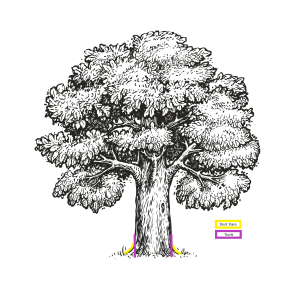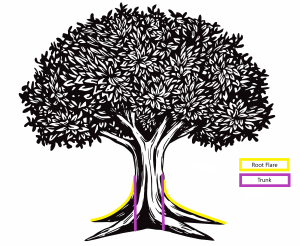Tree Ownership, Right to Prune, and Easements
Tree Ownership and Responsibility
A tree is owned by the owner of the property where the trunk of the tree stands. Maintenance of the tree and the mitigation of any hazardous situations are the responsibility of the tree owner. If a tree branch stemming from a tree with a trunk on one property grows over another property, the owner of the property where the trunk is located is responsible for mitigating any hazardous conditions associated with the branches. A ‘root flare’ is not considered part of the trunk for the purposes of ownership determination. Routine clean up of leaves and minor fallen branches are the responsibility of the property where they fall.
Trees on Property Lines
Some tree trunks straddle property lines and are therefore co-owned by the two properties. If a tree is co-owned, its maintenance is the equal responsibility of both owners. Note that the City does not make determinations on where a property line is located as a surveyor is required for this. In all cases neighbors are encouraged to work together to determine where the property line is, whether or not the tree is co-owned, and how they will manage maintenance costs.
- For a tree with a trunk growing vertically, the trunk location should be assessed by imagining a vertical line drawn down from the edge of the trunk measured at 4.5 feet from the ground.
- For a tree with a lean or bend, the location of the trunk shall be measured at the point below where the lean or bend begins, excluding any root/trunk flares that may grow from the trunk.
Right to Prune Branches Hanging Over Property Lines
As per State of Maryland policy, branches that hang over one’s property from a tree located on an adjacent property may be pruned back to the property line, as long as the tree is not excessively damaged or destroyed in the process. See the City page on State and County Tree Regulations for more information. Note that you are still required to submit a Tree Impact Assessment if you intend to prune more than 10% of the live crown of the tree and the City may restrict the amount of pruning that may be conducted.
Easements
Easements are legal arrangements that give an entity other than the property owner certain rights or restrictions-of-use to a portion of the property. Restricted uses may include not being allowed to build a structure, cut a tree, or plant a tree within an easement, depending on the purpose of the easement. It is a good idea to familiarize yourself with any easements associated with your property as they may dictate how you must manage trees.
Forest Conservation Easements
Forest conservation easements are sometimes held by the Maryland National Capital Parks and Planning Commission (MNCPPC). A perpetual property right is granted to MNCPPC through the title of the land. These easements typically prohibit removing vegetation or changing the natural character of the land without written permission from MNCPPC.
For more information, visit Forest Conservation Easements by Montgomery Planning
Washington Suburban Sanitary Commission Easements (WSSC)
WSSC sometimes holds an easement on a property for water and sewer line management. However, most WSSC lines run in public space, not on private property so this is not very common. These easements typically restrict what vegetation or landscaping, including trees, may be allowed to grow and guarantee that WSSC has access for inspection and maintenance activities.
For more information, visit Land Services Section WSSC Water
Easements with The City of Takoma Park
The City of Takoma Park holds some easements on private properties for storm water management infrastructure. These easements may restrict what vegetation or landscaping may be allowed to grow, including trees. These easements allow the City adequate access for inspection and maintenance.


